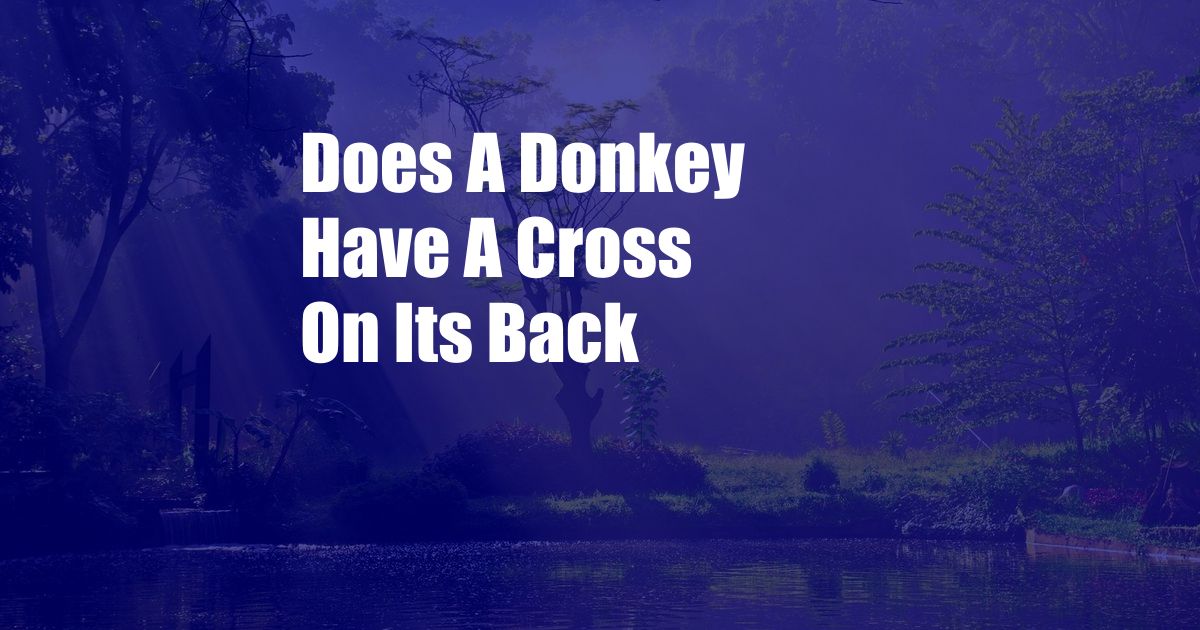
Does a Donkey Have a Cross on Its Back?
Have you ever wondered why donkeys have a dark cross-shaped marking on their backs? This distinctive feature is often attributed to a biblical story, but is there any truth to the legend? In this article, we’ll explore the fascinating history and symbolism behind the donkey’s cross.
According to Christian tradition, a donkey carried Jesus into Jerusalem on Palm Sunday. Some believe that as Jesus rode on the donkey’s back, his cross-shaped shadow was permanently etched into the animal’s fur.
The Cross of the Donkey
The cross-like marking on a donkey’s back is formed by the intersection of two dark stripes: a dorsal stripe running along the spine and a shoulder stripe crossing it perpendicularly. These stripes are common in many species of equines, including horses and zebras, but they are particularly pronounced in donkeys.
The cross-shaped marking has no known evolutionary purpose. It is believed to be a genetic trait that may have played a role in protecting donkeys from predators in the wild. The dark stripes may have camouflaged them in dense vegetation or broken up their outline, making them less visible to potential threats.
Beyond its possible evolutionary significance, the donkey’s cross has acquired cultural and religious meanings over centuries. In many cultures, the cross is a symbol of Christianity, representing both suffering and redemption. The presence of a cross on the back of a donkey has therefore been interpreted as a sign of divine favor or blessing.
Crosses in History
The cross-shaped marking on donkeys has been noted throughout history. In ancient Egypt, donkeys were depicted with crosses on their backs in hieroglyphics. In the Bible, the prophet Zechariah mentions donkeys with “stripes between their eyes” (9:9), which some scholars interpret as referring to the cross-shaped marking.
During the Middle Ages, the donkey’s cross was often associated with the crucifixion of Christ. In Christian iconography, donkeys carrying crosses are frequently depicted as symbols of humility and endurance. In some European countries, it was believed that donkeys with perfect cross markings were particularly blessed and should be used to carry religious relics and sacraments.
Today, the donkey’s cross continues to hold cultural and religious significance in many parts of the world. In some countries, it is considered good luck to own a donkey with a well-defined cross. In others, it is believed that the cross protects the animal from harm or brings good fortune to its owner.
Modern Trends and Interpretations
In recent years, there has been renewed interest in the symbolism of the donkey’s cross. Some scientists believe that the marking may be a remnant of a prehistoric species of donkey that had more distinct cross-shaped stripes. Others have suggested that the cross may be a genetic mutation that has persisted over time.
From a cultural perspective, the donkey’s cross has become a symbol of diversity and inclusion. In some communities, it represents a connection to the past and a shared heritage. It has also been used to promote understanding and tolerance between different cultures and religions.
Tips for Observing the Cross
If you are curious to see the cross-shaped marking on a donkey, there are a few tips to keep in mind:
- Best time to observe: The cross is most visible in young donkeys, as it tends to fade with age.
- Grooming: A clean and well-groomed donkey will make it easier to spot the cross.
- Lighting: Natural daylight or bright artificial light will help to highlight the marking.
- Perspective: Standing at a slight angle to the donkey’s back may provide the best view.
It is important to approach donkeys with respect and not attempt to touch them without permission. If you are unsure whether it is appropriate to view a donkey’s marking, please ask its owner or caregiver for guidance.
FAQ About the Donkey’s Cross
Q: Is the cross-shaped marking on a donkey’s back a religious symbol?
A: The cross has religious significance in Christianity, but its presence on a donkey’s back is primarily a natural genetic trait.
Q: What is the purpose of the cross on a donkey’s back?
A: The cross has no known evolutionary purpose. It is believed to be a remnant of a prehistoric species or a genetic mutation that has persisted over time.
Q: Do all donkeys have a cross on their backs?
A: Most donkeys have a cross-shaped marking, but it can vary in size and definition. Some donkeys may have a faint or incomplete cross, while others may have a very pronounced one.
Q: Is it good luck to own a donkey with a cross on its back?
A: In some cultures, it is considered good luck to own a donkey with a well-defined cross. However, there is no scientific evidence to support this belief.
Q: How can I tell if a cross on a donkey’s back is real or painted on?
A: A real cross is a natural marking that is part of the donkey’s fur. It will be present from birth and will not fade away with time. A painted-on cross will typically be less defined and may smudge or fade over time.
Conclusion
The donkey’s cross is a fascinating and enduring symbol that has captured the imagination of people for centuries. Whether viewed through a religious, cultural, or scientific lens, it is a reminder of the diversity and interconnectedness of all living creatures.
If you are intrigued by the topic, we encourage you to do further research and share your own experiences and insights with us in the comments below.